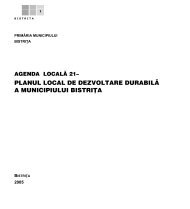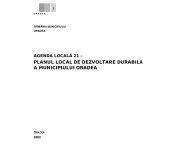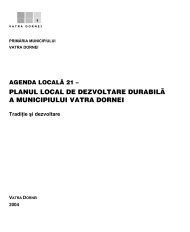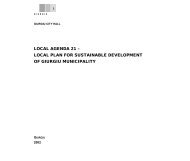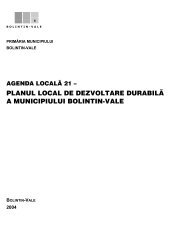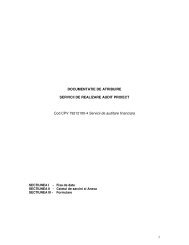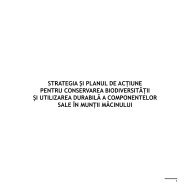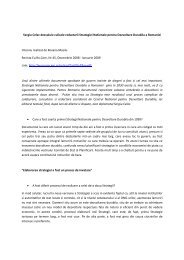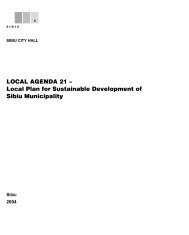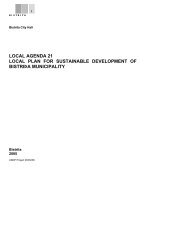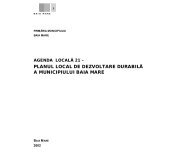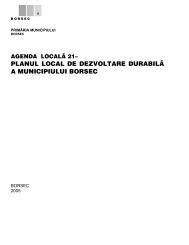English Version - United Nations Development Programme Romania
English Version - United Nations Development Programme Romania
English Version - United Nations Development Programme Romania
You also want an ePaper? Increase the reach of your titles
YUMPU automatically turns print PDFs into web optimized ePapers that Google loves.
The geological reserves of ferrous and non-ferrous resources (in state ownership) that are pay-ore<br />
using the current mining technologies are presently estimated as:<br />
40 million tons of gold and silver ore;<br />
90 million tons of poly-metallic ores;<br />
900 million tons of copper ore;<br />
4 billion tons of salt.<br />
The <strong>Romania</strong>n subsoil also contains deposits of rare and radioactive metal ores, manganese-iron,<br />
bauxite and a large variety of ferrous substances and rocks used in industry.<br />
The main mining consumers of ores are:<br />
Non-ferrous metallurgy and steel industry, chemical industry for ore products (metallic concentrates)<br />
Chloride and sodium industry, domestic consumption (salt)<br />
Paper, ceramics, glass, plastics, rubber, finishing varnish, paint, electrical engineering and food<br />
industries<br />
Non-ferrous metal ores and gold and silver are found in small and medium size deposits and with<br />
low metallic potential.<br />
The metal content in the mined ore is small. The metallurgic value of a reserve tone from the used<br />
deposits in <strong>Romania</strong> is $5-7 per ton, 3-4 times less than the deposits exploited internationally under<br />
profitable conditions.<br />
The non-ferrous deposits are also of rather poor quality.<br />
As an effect of the unpromising geological and mining characteristics of the exploited ore<br />
deposits, and due to the small metal content of the ores, as well as to the reduced reliability of the<br />
working equipment, the cost of mining products is generally well above the market prices. Thus, the state<br />
supports the ore mining activity and the production of non-ferrous concentrates and precious metals by<br />
providing subsidies.<br />
4.3.2 Energy resources<br />
a) Oil and gas<br />
<strong>Romania</strong> has a land and sea surface of about 130,000 km² that allows hydrocarbons to<br />
accumulate, but geological conditions are varied, considerably influencing the exploration and<br />
exploitation activities.<br />
Seismic and drilling operations to a depth of up to 4,000 m are advanced in all geological units,<br />
except the Oriental Carpathians area, where the tectonics is complex, the surveying technologies are<br />
insufficient and the access roads do not allow for a sustained development of geological works.<br />
According to some results released by the American Prospecting Department, <strong>Romania</strong> has<br />
oil reserves of about 200 million tones and natural gas reserves of about 400 billion m³, found at<br />
depths of over 4,000 m and in complex geological conditions.<br />
The actual potential is made up of the existing reserves (73.4%) and prospective reserves<br />
(26.6%). Of the total existing reserves of natural gas deposits, about 64% have pressures in excess of 20<br />
atm, out of which the Transylvania Depression (the main national supplier) holds only 57% of the<br />
reserves.<br />
b) Coal<br />
In <strong>Romania</strong>, coal plays important parts as a primary energy source supply. Thus, in 1998, 20.6%<br />
of the internal primary energy production came from coal.<br />
The geological coal reserves exploitable in the present technical-economic context are estimated<br />
at about 3,433 billion tons, of which 2,620 million tons lignite, 0,759 million tons bituminous coal, and<br />
0,054 million tons brown coal.<br />
The impact that the coal quality has on the main users as well as on the coal market is influenced<br />
by the following factors: the cost of energy production for the users, which is determined by the coal<br />
quality; the high degree of pollution caused by incomplete combustion. Additional problems are the<br />
elimination of gases and ensuing ashes, and large areas taken up for mining purposes, thus making them<br />
unavailable for other types of economic activitie s. At the same time, the technologies used in the<br />
extraction and refining of coal are below the level of those used in EU countries, partly due to the reduced<br />
reliability of the technologies applied, and partly to geologic and mining conditions that do not allow for<br />
advanced methods of exploitation. All these specific conditions lead to high production costs and to<br />
the lack of competitiveness of this industrial branch, as compared to the EU countries.<br />
The problems that arise when drawing up a development strategy for the coal extracting industry<br />
are linked both to the economic and energetic limitations of the deposits under exploitation, and to the<br />
limit to which they can be used to produce thermal and electrical energy.<br />
28



